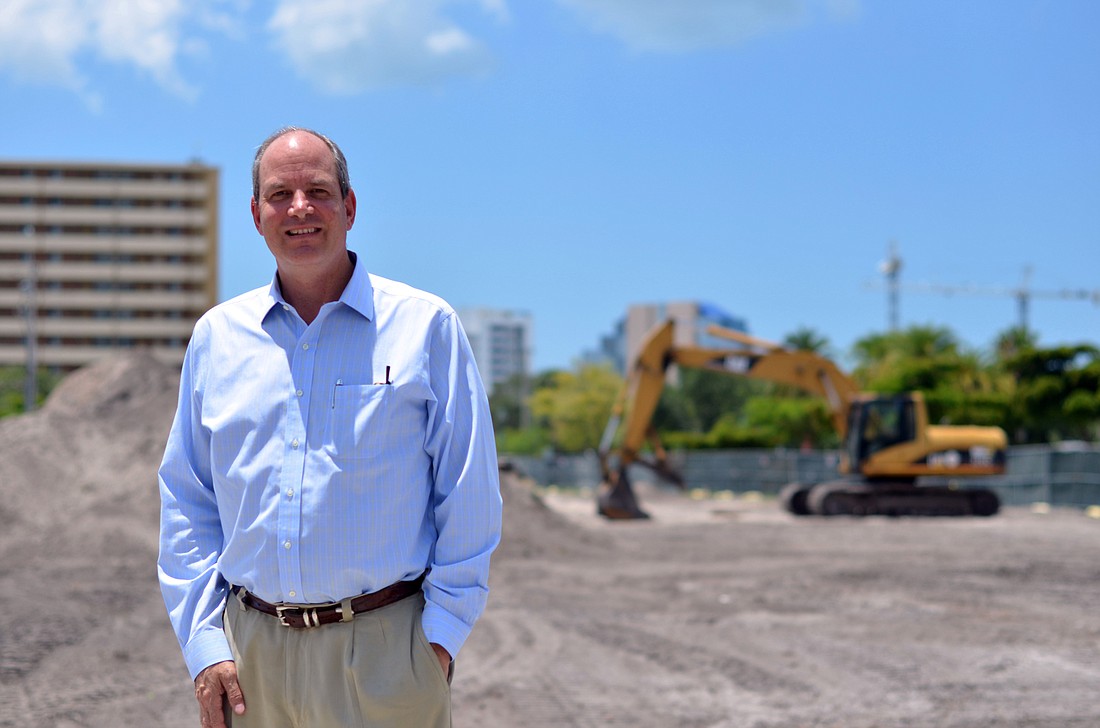- April 26, 2024
-
-
Loading

Loading

The Rosemary Residential Overlay District, a much-lauded density bonus in a segment of the city in need of redevelopment, was created to accommodate a single housing project. Jay Tallman, the head of Ascentia Development Group, is teaming with property owner Rosalyne Holdings to build the 450-unit CitySide apartment project on 6.5 acres of land in the Rosemary District.
We talked to Tallman about the significance of that city-created density bonus, the challenges associated with moving into a new area and his outlook on the future of the Rosemary District.
Q: From a developer’s perspective, how big of an incentive is the density increase the Rosemary Residential Overlay District created?
A: I think it’s pretty significant and I think it’s a game-changer in terms of the economics and feasibility of going into that area. I think the developers are having to be pioneers, to a certain extent, going into the Rosemary District — though it certainly has a great deal of potential. I think all of us here in Sarasota recognize the potential, but there have been some challenges over recent years. This greatly improves the economics, and now we're seeing the fruits of that effort. There are a number of projects being proposed now, multifamily projects. I think it definitely changed the landscape as far as promoting new development in the Rosemary District.
"If you can concentrate density in key urban areas, it can actually be handled efficiently and bring important economic investment into the area."
Q: “Density” is a word that often gets a suspicious reception in Sarasota. What would you say to residents wary of any density increases in the city?
A: Actually, density — if handled properly — is a good thing for an area. It brings economic investment into an area, and that's needed to turn an area around. There are many cities around the United States that will actually encourage density, because it can be more efficiently managed. We talk about urban sprawl — well, urban sprawl is oftentimes brought about as a result of an area where the government discourages density. It creates inefficiency in how you handle traffic, utilities. When we hear it said that growth doesn't pay for itself and new development doesn't pay for itself, that can be true if you're dealing with low density and urban sprawl. But if you can concentrate density in key urban areas, it can actually be handled efficiently and bring important economic investment into the area.
Q: What are your thoughts on the city’s ongoing shift to a form-based zoning code?
A: I like form-based codes. They make more sense for the most part. Obviously, the devil's in the details, and that's all still coming. I've been doing some development in Denver, and Denver adopted a form-based code probably about eight or 10 years ago. I've been impressed with, overall, how the code works. For instance, they don't tell you how many units you can have on a property. They tell you what the envelope is you have to work within, and they have other requirements that ultimately pretty much dictate what you can do. It's really driven by other form-based considerations in the property. I think it's a good thing. I think many cities and counties are moving in that direction.
Q: How much room for growth is there in the residential market in the Rosemary District? With several projects in development, are there any concerns about oversaturation?
A: I think it's a good question. I don't know that anybody has a clear answer to that, actually. I think there's a definite demand for multifamily housing in and near the downtown area, but there's really no precedent for this. Ultimately, the market is going to dictate what that limit is. The funding for projects is going to get more difficult, perhaps, as the market gets tighter in terms of demand and supply for multifamily housing. I think the timing of the different projects is going to be spaced out enough where the third or fourth down the line, they're going to start seeing there may not be as much demand for that, and that it may be best to hold off on proceeding for now. It's a market-driven thing, really. For our project, we feel good, because we're one of the first out of the gate here. We feel confident CitySide will do well in the marketplace. The other thing that drives this is cost continues to go up for projects that come along later. Cost structures are different, forcing them into getting higher rents.
Q: Are there any lingering concerns about being one of the first groups to invest in the Rosemary District post-recession?
A: Obviously we're monitoring the homeless situation very closely. We think there are steps being taken now to improve that situation. But we also think that, through the significant economic shot in the arm that our project and other projects in the area are going to have for that district, that will help the situation as well. Typically, in other cities I'm familiar with, I've seen similar circumstances that have been very successful in turning an area around. But there definitely needs to be an effective policy regarding the homeless that is employed in the Rosemary District.
Q: Do you think it would be a good idea for the Rosemary District to join the self-taxing Downtown Improvement District?
A: I haven't had a chance to fully analyze that, but I do think — on the outset — I think it could be favorable for the Rosemary District. I think the Rosemary District, being immediately adjacent to downtown, shares a lot of similar interests, and I think it could help promote the commercial development within the Rosemary District, which I think is important as a counterbalance to the residential development that’s now taking place.